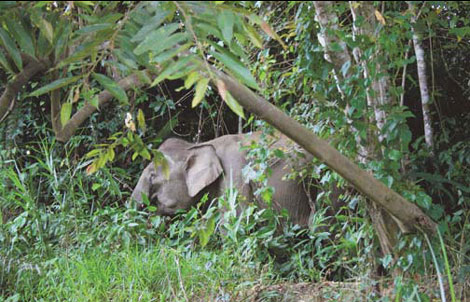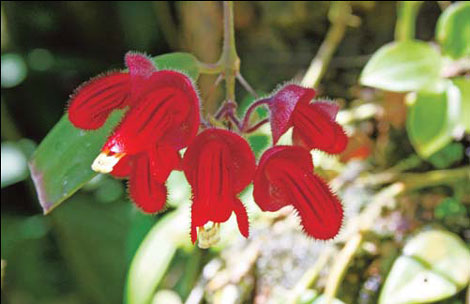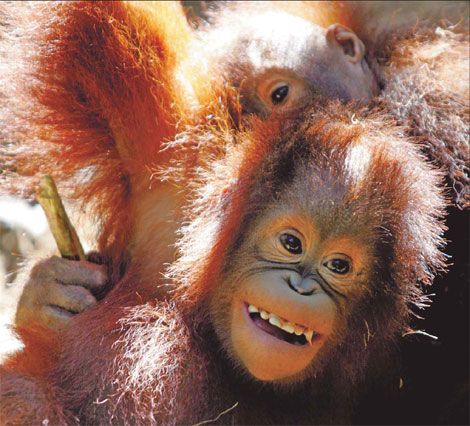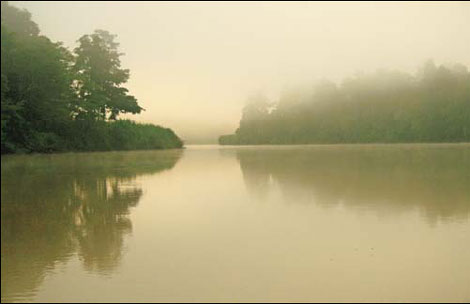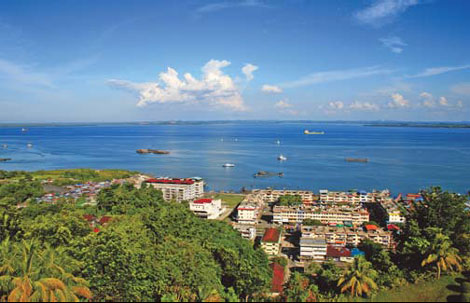Welcome to the jungle
Updated: 2011-12-08 07:55
By Sindy Chan (China Daily)
|
||||||||
|
Borneo pygmy elephants, the world's smallest elephant species, are naturally shy. Photos by Sindy Chan / For China Daily |
|
A huge variety of tropical flowers can be found in Sandakan's forest. Photos by Sindy Chan / For China Daily |
|
Orangutans are one of the most celebrated jungle dwellers. Li Jiuhong / For China Daily |
|
The Kinabatangan River is enveloped in fog. Photos by Sindy Chan / For China Daily |
|
Sandakan Bay overlooks the Sulu Sea. Photos by Sindy Chan / For China Daily |
A small town in a Malaysian rainforest reserve blends idyllic charm with exciting excursions. Sindy Chan reports.
The trees sounded, leaves clapping together like applause to announce the orangutans' arrival.
We had been waiting with more than 100 spectators at the Sepilok Rehabilitation Center, about 40 minutes drive from Sandakan town, which is next to a nature reserve in Malaysian Borneo.
We could hear, but couldn't see, them. Suddenly, one blasted across the tree canopy.
"An orangutan and a baby!"
Everyone cheered as an orangutan mother clutching a tiny tike landed on the feeding platform.
More came. The playful orangutans weren't shy. They showed off, jumping around and performing aerobics on a rope.
Others at the feeding platform turned their backs to the crowd for a little privacy.
The twice-a-day feeding sessions are part of the rehabilitation program to help the animals make a smooth transition from captivity to the wild.
Semi-independent orangutans on the forest's outskirts come to the feeding platform until they discover full confidence in finding their own food in the jungle's interior.
We journeyed further into the forest to search for more wild animals. We discovered a solitary orangutan in a tree nearby.
The largest arboreal, or tree-dwelling mammal, makes fresh sleeping nests from branches and foliage in the crowns of trees every night. They make simpler nests for daytime naps.
"Orangutan" comes from the Malay words for "man" (orang) and "of the forest" (utan).
"Man" is an apt word choice. Orangutans share 96.4 percent of human genes.
The orangutan population has shrunk over the past 40 years because of disruptive human activities, such as excessive logging and clearing land for plantations.
We had a little adventure on our way out of the forest.
 |
We saw two, then three, long-tailed macaques marching toward us along the boardwalk rails. Then there were four, and five and, suddenly, a long line of long-tailed and pigtailed macaques and their babies hopping toward us single file.
I immediately recalled what our guide, Johnny, had told us about macaques.
"Macaques are social animals, who live and move in big groups. If you come across them, don't make direct eye contact and don't show your teeth if you smile. Macaques see these as intimidating and may attack."
As the procession of macaques captivated our attention, a huge long-tailed male appeared out of nowhere, screeching at us.
Johnny advised us to calmly and quickly move away from this frightening male.
We fled the forest and returned to town.
The town has two main roads and few traffic lights but many roundabouts. Sandakan's low-rises and old markets are reminiscent of 1960s' Hong Kong, when Hong Kong investors and immigrants flew in and turned it into what's colloquially known as "Little Hong Kong".
Sandakan's rich history, nature and wildlife have since made it a post-cruise destination in Sabah.
The Sandakan Memorial Park was built on the site of the original Japanese camp for Australian and British prisoners of war during World War II.
As the Allies approached victory, heavy bombardments caused the Japanese to relocate 2,504 POWs from Sandakan to the inland Ranau in three marches. The 260-km trek was known as the "Death March". Only six Australians escaped alive, with the help of local villagers.
St Michael's Church, which survived the war, keeps a full record of the POWs, who spent the night there before marching to the camp.
American writer Agnes Newton Keith's house brought us back to pre-war times, when Sandakan was part of the British North Borneo Company. Keith and her family were residents of Sandakan from 1934 to 1952. She wrote two books in the house that made Sabah known to the world as the "Land Below the Wind".
The two-story British colonial-style timber dwelling is a timeless dream home for writers.
It faces Sandakan Bay and the Sulu Sea. The boundless ocean inspired the writer. Keith placed her bed in the center of the upper floor master suite, which she says made it like an island in the ocean.
The next day, we headed south.
The Gomantong Caves create Sabah's largest cavern system. It's a treasure trove of edible bird's nests, and natives have passed down the skills for retrieving the nests for centuries.
The half-hour spelunk through the Lower Black Cave was challenging. The boardwalk and railings were covered with thick layers of bird excrement, which made certain walking sections slick.
We didn't actually see the harvest, but Keith's book White Man Returns filled my imagination: Slithering over masses of cockroaches, the foragers enter bat-infested limestone caves. Using rattan ladders, they climb about 30 meters to pluck the nests from the high crevices. These contain the birds' hardened saliva - the staple of bird's nest soup.
The Kinabatangan River is Malaysia's second longest watercourse. It flows eastward into the Sulu Sea.
The 270-sq-km protected area on the lower Kinabatangan floodplain contains Borneo's highest concentration of wildlife.
In Bilit, we were among a group of eight belonging to four nationalities - Chinese, French, Italian and Japanese - on a boat trip.
We followed the scent of proboscis monkeys for some time, but the primates seemed to be hiding from us.
Male proboscises have big floppy noses, reddish buzz-cut hairstyles, white tails and body markings and red bellies. Females are much smaller and have upturned snouts.
"Look! The footsteps of elephants that came to drink the river water," our guide said, pointing to the tracks.
The motorboat driver zipped back and forth along the river, checking with his wife and fellow villagers to confirm elephants are near.
We agreed to search for the Borneo pygmy elephant instead of proboscis monkeys. Just before sunset, we finally spotted the pachyderms plodding behind the bushes.
The boatman killed the engine and used a plank to push the boat ashore. We sat quietly, peeking at the elephants munching plants. The young elephants played and a calf scrambled to catch up its family.
Borneo pygmy elephants are the world's smallest elephant species.
Unlike the orangutans at the Sepilok Rehabilitation Center, these wild creatures were shy around humans. They vanished into the forest when they sensed our presence.
We spent the night at the riverside Bilit Adventure Lodge.
I didn't set out to search for endemic nocturnal creatures, such as flying squirrels.
Instead, I snoozed in my chalet and dreamt about the soaring eagles, slithering serpents and playful otter I'd seen in the reserve.
Sabah Tourism Board director Datuk John Lim hosted a waterfront dinner the night before we left Sandakan.
The entrepreneur and his wife, Judy, chose to live in the Sepilok forest after retirement.
"By the end of this year or early next year, Sandakan will have its first Habour Shopping Mall and five-star international hotel," Lim says.
That means this little town by the jungle will never be the same.
